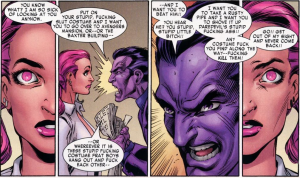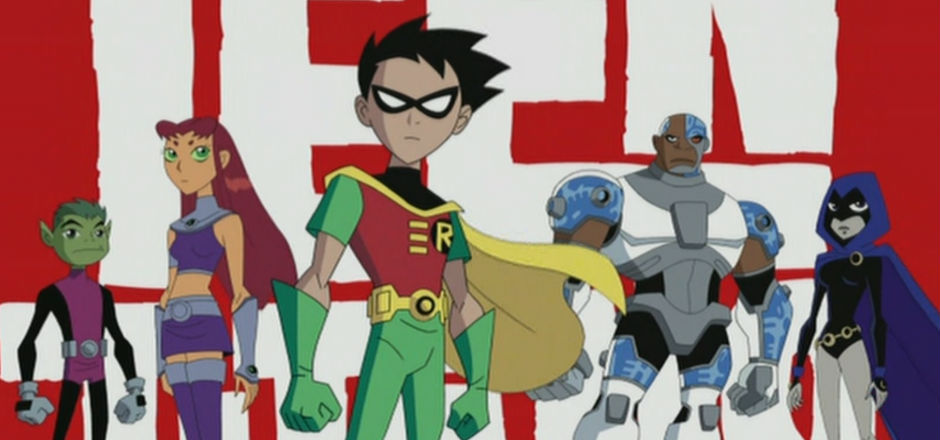Kilgrave: “We used to do a lot more than just touch hands.”
Jessica: “Yeah. It’s called rape.”
AKA Spoilers Ahead!!
It’s always been hard to compare books and comics with their TV and movie counterparts. The best adaptations are those that use their new format to not only re-tell, but also expand upon the source material in a meaningful way. Recent years have a seen a whole slew of comic-to-screen transitions. Some have been better than others (I’m looking at you, Catwoman), but overall, right now is a very good time to be a comic book nerd.
Jessica Jones is the latest Marvel work to make the jump to the tiny glowing screen in your bedroom, and it does not disappoint. In fact, it failed to disappoint me so much that I went back and binge-read Alias and The Pulse. Yes, that’s right – Netflix’s Jessica Jones was my first introduction to the character. I considered reading the comics first, but ultimately decided to judge the show on it’s own merits, and only then check out where it came from. So, how do the two works compare? Both the TV series and the comic books explore different themes —rape, addiction, PTSD, friendship, love— in the ways that are best suited to their respective mediums.
For those of you at home that have been living under a rock these past few months, both the comics and the series follow the story of the main character Jessica Jones, former superhero (Jewel) turned private investigator, and the sole employee of Alias Investigations.
There are, of course, differences between the two works, both in the addition of characters, the order of the story, and the ways in which the writers explore the underlying themes. Many of these changes have been praised by critics. For instance, switching Carol Danvers for Patricia Walker was well received by long-time fans and first-time viewers alike. But the differences that I was most intrigued by were the changes made to the antagonist, Kilgrave. These changes go beyond the superficial (although I would definitely have liked to see a purple skin David Tennant), adding nuances that make him much a more complex character than the comics let on.
So let’s start with Zebadiah Killgrave —yes, that’s Killgrave with two ‘Ls’—, aka “the Purple Man.” In the comics, he has a very different background than he does in the series. Killgrave was first introduced to the Marvel Universe back in 1964 as a foe of Daredevil. His first “Jessica Jones” appearance was the antagonist in The Secret Origins of Jessica Jones (issues #22-28). As Jessica opens up to her friend Luke Cage, we find out that one of the reasons that Jessica left the superhero business is that he had kidnaped her for EIGHT months in order to get back at Daredevil for making a fool out of him. Throughout this time, Killgrave psychologically and emotionally tortures her. While both the comics and series depict Killgrave’s abusive behavior towards Jessica Jones, they do so in different ways.
The comics focus on the psychological abuse he puts her through. No physical rape may have been involved, but he still uses his mind-controlling powers to make Jessica want him sexually and makes her “beg for it,” only for him to refuse her again and again. More notoriously, readers of Alias will remember that Jessica narrates how Killgrave would pick up college girls from the streets and have sex with them in front of her, while he making her wish that she could take their place. On the other hand, the TV series explicitly lets the viewer know that Jessica was raped during her captivity.
 Alias: The Secret Life of Jessica Jones (#25)
Alias: The Secret Life of Jessica Jones (#25)
When you finish reading Alias, it’s easy to conclude that Killgrave is just plain evil. In Jessica Jones however, writer Melissa Rosenberg doesn’t make it that easy for us. The TV format gives Rosenberg the opportunity to better explore Kilgrave’s character and his relationship with Jones.
As we can see in the series, Kilgrave is not merely carrying out a vendetta against Jessica. He is actually obsessed with her, and his pursuit of power is fueled by his need to control Jessica, both in mind and body. His obsession goes as far as declaring his undying love for her at a police station —while holding everyone at gunpoint. Even without affecting his powers of mind control, Kilgrave still manages to manipulate Jones and take hold of her, as Jessica Lachenal points out. All of this is juxtaposed wonderfully with the casting choice for Kilgrave —played by the charming David Tennant.
Together, all of these elements work perfectly to present an antagonist that is much more real than a stereotypically two-dimensional comic book villain. While the comic explores the issue of emotional abuse, the TV series expands on this idea to include the issues of consent and respect. One can easily extract this situation —minus the literal mind control— and place it in the real world, where it would not seem any different from any other relationship where one partner manipulates the other into staying locked in the cycle of abuse. Overall, the added realism and depth that Rosenberg was able to give to the characters and the story is incredible.
Marvel’s Jessica Jones, “AKA WWJD?” (S1:E8)
A key difference between the comics and the Netflix series is the way that Jessica breaks free from Kilgrave’s control. In the comic books, after a burst of anger the Purple Man gets tired of Jessica, so he lets her go and sends her to kill Daredevil. In the series, it is Jessica herself that breaks free from Killgrave. This critical detail makes this scene even much more powerful because it shows the struggle that actual victims of abuse go through when leaving their abusers.
Up: Alias #25; Down: Marvel’s Jessica Jones, “AKA You’re a Winner!” (S1:E6)
In the comics, Jessica goes on to search for Daredevil, but unfortunately for her, she confuses the Scarlet Witch’s headpiece for Daredevil’s. After Jessica knocks her to the ground, both the Avengers and the Defenders proceed to beat her into a coma before realizing she had been “Killgraved.” After months of recovery under the care of S.H.I.E.L.D., the X-Men’s Jean Grey helps Jessica come out from the coma, while building a mental barrier that later on helps Jessica break free from Kilgrave.
[blocktext align=”right”]In the comic books, after a burst of anger the Purple Man gets tired of Jessica, so he lets her go and sends her to kill Daredevil. In the series, it is Jessica herself that breaks free from Killgrave.[/blocktext]In the TV series, this is not the case. In fact, it is suggested that the shock from killing Reva Connors is what brings Jessica “out of it.” Again, this is much more in line with what an actual abusive relationship looks like. While abusive relationships can sometimes have abrupt endings that involve abandonment or escape, when an abused party leaves the abuser it is usually much more chaotic. Additionally, pain, suffering, and the ability to overcome adversity are not things you can turn on and off with a switch, which is something that both comics and series show. Yet the fact that there was no superhuman element involved gives much more strength to Jessica’s character than the comic books ever did.
Overall, the series manages to make the situation that Jessica finds herself in feel more human than the comic does, and therefore, much scarier. The abusers that exist in the real world are rarely some criminal mastermind, wanted by every organization. Most of the time it is the person you would least expect, someone that seems harmless to the rest, someone that easily blurs the line between love and obsession, the smooth-talker that no one expects to be capable of something like that (say, a charming British man, for example). While comic book Killgrave in the comics uses mental abuse and torture as a weapon in a war between superheroes and villains, TV series Kilgrave uses his powers to directly attack Jessica, not just as a superhero, but as a woman and a human being. It is precisely this personal element of the series that makes the story so relatable to many, and makes for a graceful representation of what the aftermath of abuse is.
It could be argued that the comic offers a third-person experience, while the series offers more of a first-person/intimate experience of Jessica Jones as a character. In the comics, we meet Jessica in a certain point in her life, and Jessica’s past becomes this big reveal that explains certain (if not all) traits of her character; in the TV series, we learn about Jessica’s past very early in the series, and it becomes an essential part of the viewer’s plunge into discovering the intricate details of Jessica’s personality. Both viewpoints are different yet complementary ways of exploring the main themes of both stories, and while they portray the same character they show different experiences towards rape, abuse, and recovery.
—
Katherine Elisa Ruiz-Díaz is a Graphic Novel Reviewer at Girls in Capes from Puerto Rico. She holds a B.A. in History, with minors in French and Biology, from Boston University, and is currently pursuing a degree in Law. She enjoys reading anything related to sci-fi and fantasy, and hides under the covers to read non-fiction and history books. Katherine is also an anime and TV junkie, and thinks that RPGs are the only video games truly worth playing. When she’s truly bored, she likes to sketch and paint. Find her on Goodreads.
Read more in our birthday celebration here.










